Guderian
Kapteeni
Sen jälkeen auto suistui tieltä ja räjähti libyalaisten tulituksessa
niin ja paljonkohan porukkaa kuoli ko. räjähdyksessä. Pakko kai Libyalaisten oli näyttää että osutaan mekin.
Follow along with the video below to see how to install our site as a web app on your home screen.
Note: This feature may not be available in some browsers.
Sen jälkeen auto suistui tieltä ja räjähti libyalaisten tulituksessa

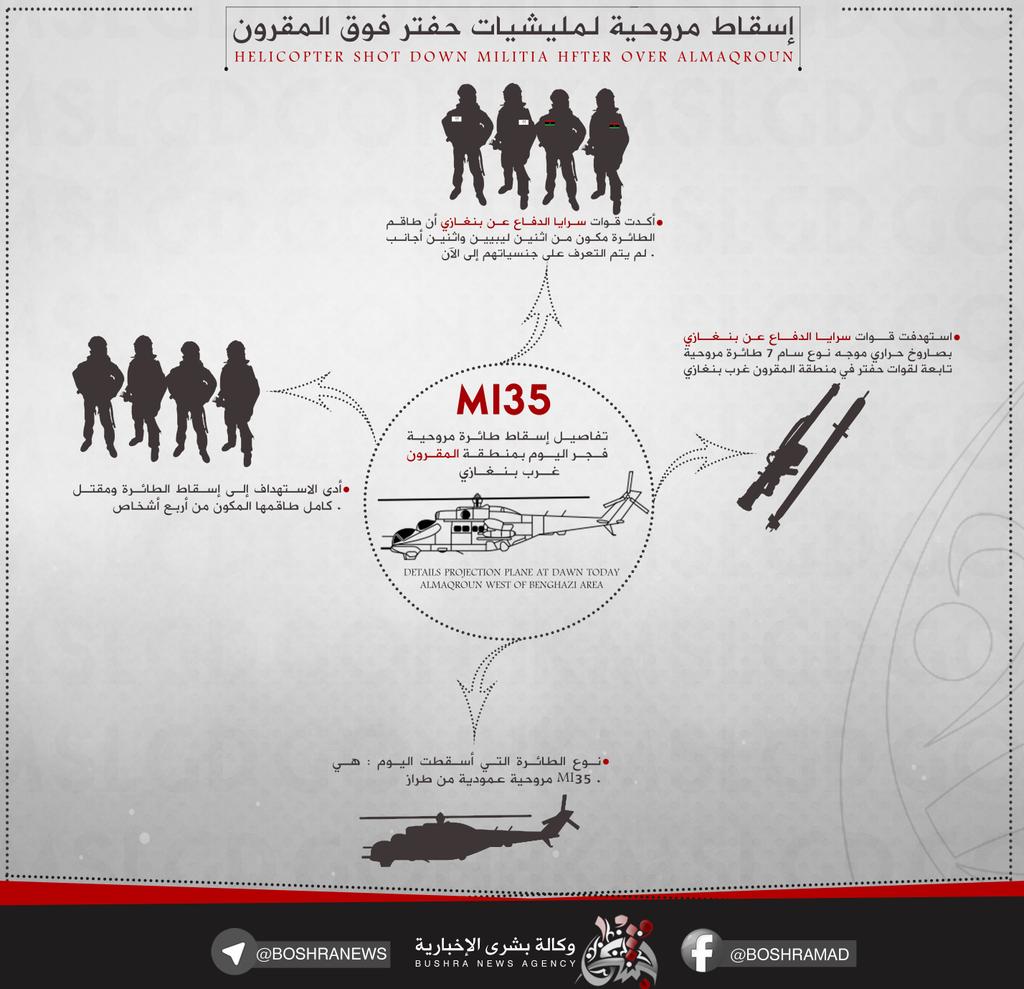
A helicopter carrying three French soldiers crashed near Benghazi, Libya earlier this week. The French government subsequently confirmed that all three soldiers, along with their Libyan counterparts, were killed. The circumstances surrounding the crash remain murky, but jihadists and Islamists inside Libya have been rattling their sabres ever since the presence of French special forces was confirmed.
A new front calling itself the Benghazi Defense Brigades (BDB) quickly claimed credit for downing the helicopter. On Jul. 17, the BDB’s propaganda arm posted an infographic (seen above) indicating that the chopper was downed with a shoulder-fired missile. The infographic was published on the BDB’s official website and Twitter feed.
The BDB subsequently produced four photos (seen below) purportedly showing the wreckage of the helo, which it identified as a Russian-made Mi-35. (The Long War Journal cannot independently verify the type of helicopter shown.)
Two anonymous officials quickly confirmed to the Associated Press that the helicopter had been shot down. The AP described the officials as “an air force officer who knew of the helicopters’ passengers” and “an official working for Western missions in Libya.”
The French government initially declined to comment on the incident, given the clandestine nature of France’s role in Libya. The Western nation has special forces embedded alongside fighters loyal to General Khalifa Haftar, who has been waging a fierce campaign against jihadists in Benghazi and elsewhere. However, the French have not advertised the relationship, which generated controversy as soon as it was revealed.
During a speech on July 20, French President Francois Hollande blamed the deaths on an “accident.”
“At this moment we are carrying out dangerous intelligence operations [in Libya],” Hollande said, according to Reuters. “Three of our soldiers, who were involved in these operations, have been killed in a helicopter accident.”
Ahmed Masmari, a spokesman for Haftar, echoed Hollande’s statement. Masmari said it was “probably a technical problem” that caused the crash. He also claimed that the French were “gathering intelligence on fighters from Boko Haram” who had relocated to the area. Boko Haram swore allegiance to the Islamic State last year and was rebranded as the Islamic State’s “province” in West Africa.
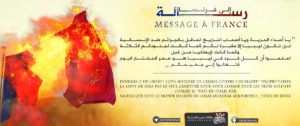
The BDB has rejected Hollande’s claim. And within hours of his speech, the group threatened France. Libya will turn into a “graveyard for you as it was for your three soldiers” and just as it “was for Italy before,” a statement from the BDB on July 20 read. One of the BDB’s threats can be seen on the right.
According to two unnamed Libyan officials and a militia member cited by the Associated Press, a French warplane retaliated by bombing an area outside of Benghazi on Jul. 20.
Then, earlier today, the BDB tweeted a photo allegedly showing one of the dead French soldiers, reiterating its claim to have shot down the helicopter carrying them.
The Benghazi Defense Brigades (BDB) posted these photos allegedly depicting the downed helicopter that carried three French soldiers:

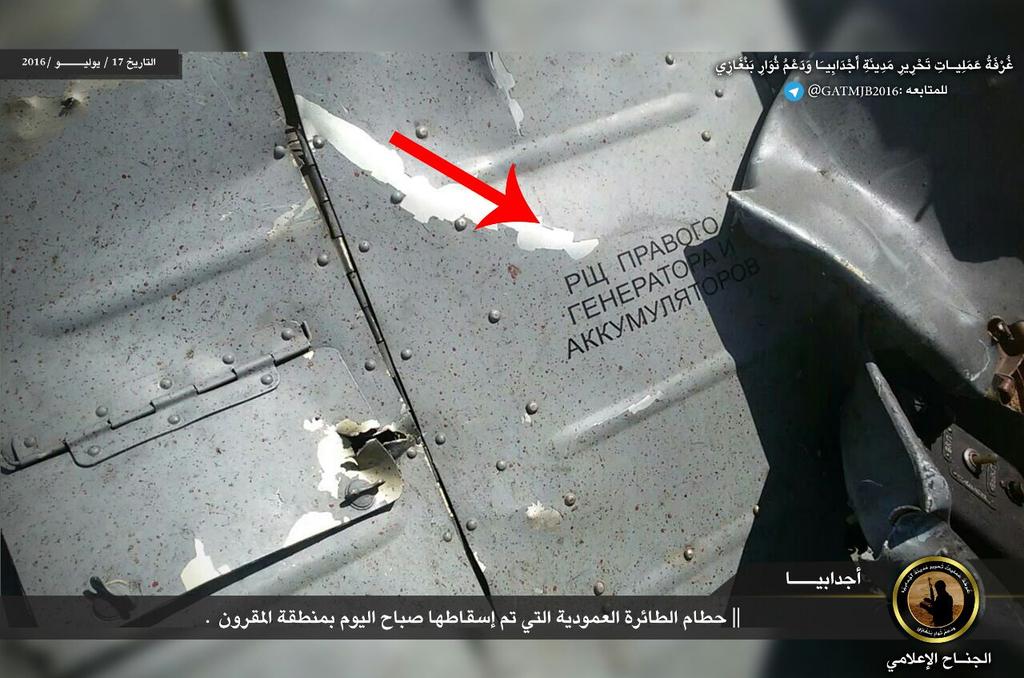
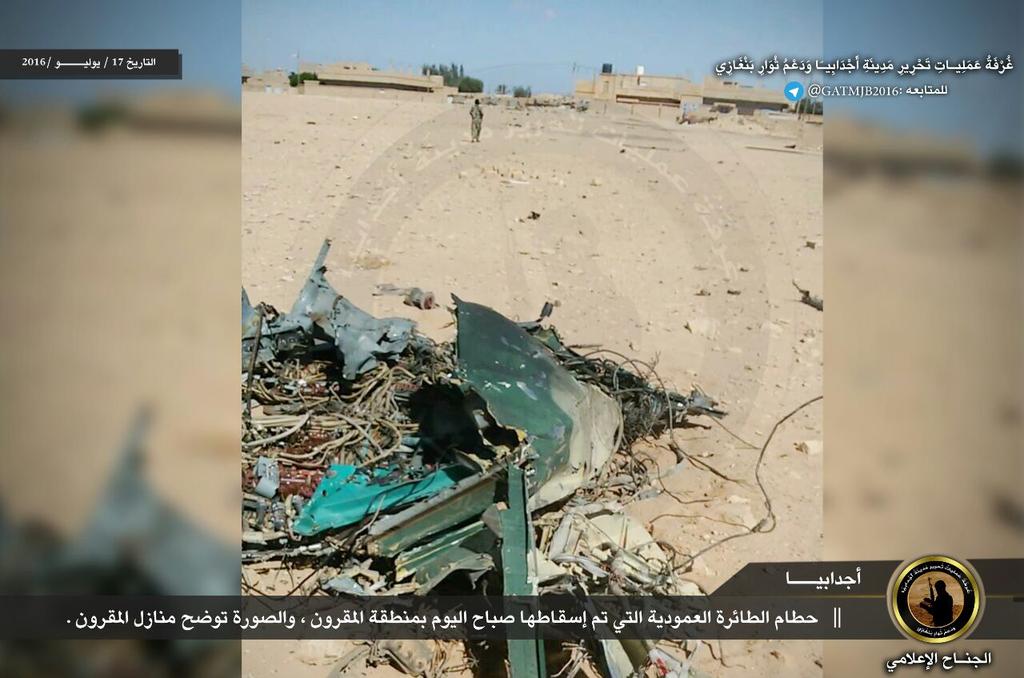
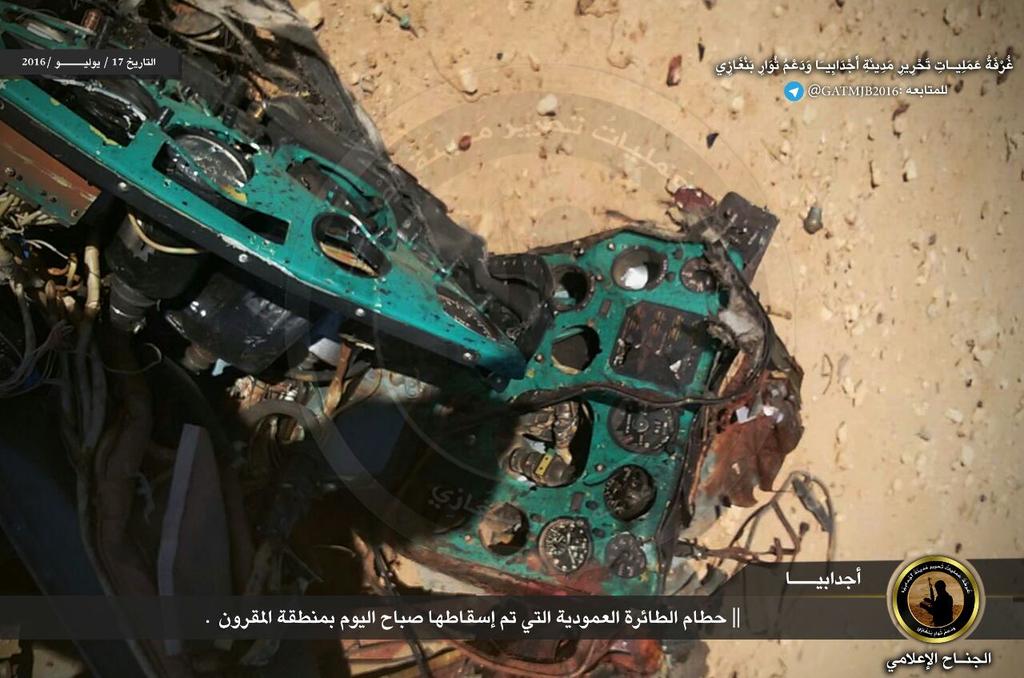

The US military acknowledged today that it has targeted the Islamic State’s Libyan arm in the city of Sirte. The air strikes are part of an effort to deal a blow to the jihadist group in its largest base of operations inside Libya.
“Today, at the request of the Libyan Government of National Accord (GNA), the United States military conducted precision air strikes against ISIL [Islamic State] targets in Sirte, Libya, to support GNA-affiliated forces seeking to defeat ISIL in its primary stronghold in Libya,” the Pentagon stated in a press release.
“These strikes were authorized by the president following a recommendation from Secretary [of Defense] Carter and Chairman [of the Joint Chiefs of Staff] Dunford,” the statement continued. “They are consistent with our approach to combating ISIL by working with capable and motivated local forces. GNA-aligned forces have had success in recapturing territory from ISIL thus far around Sirte, and additional US strikes will continue to target ISIL in Sirte in order to enable the GNA to make a decisive, strategic advance.”
The airstrikes were confirmed by Libya’s prime minister and Al Bunyan Al Marsoos (“Solid Structure”), an operations room that is allied with the UN-backed government and recruits fighters from Islamist militias in Misrata and elsewhere. According to Al Bunyan Al Marsoos, an Islamic State “tank” was targeted and destroyed by US aircraft.
Al Bunyan Al Marsoos launched an offensive to retake Sirte in late May and claimed it would “be liberated within days.” While the Islamic State lost some ground during the initial fighting, the situation in Sirte has largely stalemated. American airpower was likely called in because the offensive has stalled and the US can provide superior targeting against the jihadists, who remain entrenched in the interior of the city. [See LWJ report, Libyan forces seize key points from the Islamic State around Sirte.]
As Al Bunyan Al Marsoos advanced on the city in May, the Islamic State’s Libyan “province” was forced to deploy its “martyrs.” The jihadists launched zero suicide attacks in and around Sirte during the first four months of the year, according to data published by Amaq News Agency, which is part of the the Islamic State’s media machine. But then, in May, the organization dispatched nine suicide bombers in Sirte and on the outskirts of the city. This was a clear indication that the Islamc State’s grip on the area was slipping, as the organization previously did not need to use its “martyrs” to beat back its opponents.
The loss of Sirte would be a major blow to the Islamic State and its efforts to control territory outside of Iraq and Syria. The group seized Sirte in June 2015 and has repeatedly showcased the city as one of its main bases outside of its holdings in Iraq and Syria.
Sirte is so important to the Islamic State that the group’s spokesman, Abu Muhammad al Adnani, mentioned it alongside Raqqa, Syria and Mosul, Iraq in a speech in May. Raqqa and Mosul are the de facto capitals of the self-declared caliphate and, as such, the most important cities under the jihadists’ control.
In his speech, titled “That They Live By Proof,” Adnani implicitly conceded that the Islamic State could lose one or all three of these cities. Adnani argued that neither the loss of individual leaders, nor the “loss of a city or the loss of land,” would mean that the Islamic State has been defeated as long as the jihadists retained the will to fight.
The newly announced operations in Sirte are the first publicly acknowledged airstrikes by the US in Libya since Feb. 2016, when American warplanes attacked an Islamic State training camp near Sabratha. The US targeted Noureddine Chouchane, who was described by the Pentagon as a “senior facilitator” for the so-called caliphate and was “associated with the training camp.” Chouchane is thought to be involved in two high profile terrorist attacks in Tunisia in 2015 and reportedly played a significant role in the Islamic State’s external operations network that plots and executes attacks against the West. [See LWJ report, US airstrike targets Islamic State operative, training camp in Libya.]
On Nov. 13, 2015, the US killed Wissam Najm Abd Zayd al Zubaydi, also known as Abu Nabil al Anbari, in an airstrike. Zubaydi, an Iraqi national, “was a longtime al Qaeda operative and the senior ISIL [Islamic State] leader in Libya,” according to a statement by the US military. Some accounts indicated that Zubaydi served as the lead executioner in the February 2015 massacre of Coptic Christians on the Libyan coast.
The airstrikes in Sirte highlight the expanding war against the Islamic State, which has claimed responsibility for multiple terrorist attacks in the West over the past year.
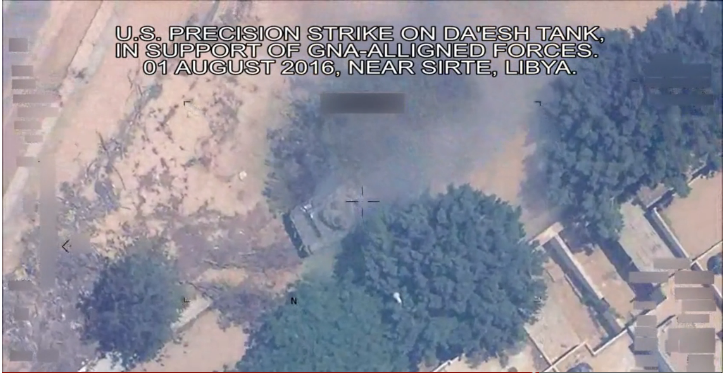
United States Africa Command announced today that it has carried out nine airstrikes in Sirte, Libya since Aug. 1. The bombings are part of “Operation Odyssey Lightning,” which is targeting the Islamic State’s positions, weapons and equipment in the city.
Five of the airstrikes took place on the first day of the air campaign, destroying two tanks (a T-72 and a T-55), “two military support vehicles,” “an enemy fighting position,” and “two pieces of heavy engineering equipment.” Four subsequent airstrikes on Aug. 2 and 3 took out a rocket launcher, “one piece of heavy engineering equipment (excavator),” “one pickup truck with mounted recoilless rifle,” and “one pickup truck with mounted recoilless rifle.”
Africa Command has also posted a video of the airstrike that disabled the T-72 tank.
As The Long War Journal noted at the outset of the airstrikes, local fighters loyal to the UN-backed Government of National Accord (GNA) had stalled in their campaign to clear the so-called “caliphate’s” fighters from Sirte. Al Bunyan Al Marsoos (“Solid Structure”), a military operations room that recruits fighters from Islamist militias in Misrata and elsewhere, made progress during the first weeks of its offensive in late May and early June. But the Islamic State is hunkered down inside the city and this prompted the GNA and Al Bunyan Al Marsoos to call in air support from the Americans.
US Africa Command says that the bombings and other actions “taken previously” are intended to “deny Daesh [Islamic State] a safe haven in Libya from which it could attack the United States and our allies.”
In February, the US targeted a Tunisian named Noureddine Chouchane. The Pentagon described Chouchane as a “senior facilitator” for the Islamic State in Libya. He had been implicated in high-profile terrorist attacks in neighboring Tunisia. The Defense Department also suggested that Chouchane could “potentially” be involved in “planning external attacks on” American “interests in the region.”
ARNO RYDMAN
18 minuuttia sitten
Hallituksen joukot ja Isis ovat taistelleet Sirten hallinnasta kesäkuusta lähtien.
Libyan YK:n tukeman hallituksen joukot ilmoittivat keskiviikkona vallanneensa Isisin viimeisen tukikohdan Libyassa, Sirten rannikkokaupungissa, kertoo The New York Times.

Sirte sijaitsee Pohjois-Libyassa Välimeren rannalla.
(Google Maps)
Yhdysvallat tukevat YK:n neuvotteleman Libyan kansallisen yhtenäisyyden hallituksen joukkoja ilmavoimillaan.
Mikäli valtaukselle saadaan vahvistus, se merkitsisi vakavaa takaiskua Isisin suunnitelmille levittäytyä Pohjois-Afrikkaan. Jihadistit ovat joutuneet perääntymään aikaisemmin tänä vuonna tärkeiltä alueilta Irakissa ja Syyriassa.
Libyalaismedian mukaan joukot etsivät jäljelle jääneitä Isis-jihadisteja, jotka piileskelevät kaupungissa. Joukot ilmoittivat vallanneensa vahvasti linnoitetun Ouagadougoun konferenssikeskuksen, jota Isis on käyttänyt päämajanaan.
Al-Ahrar televisioasema latasi Twitter-tililleen kuvia, joissa väitetysti hallituksen joukkojen taistelijat poseeraavat lippunsa kanssa.
Yhtenäisyyshallitusta tukevat joukot aloittivat hyökkäyksen Sirteen kesäkuussa. Sirteä on pidetty Isisin tärkeimpänä tukikohtana Syyrian ja Irakin ulkopuolella.
Isis valtasi rannikolla sijaitsevan Sirten runsas vuosi sitten. Libya on ollut sekasortoisessa tilassa sen jälkeen, kun Muammar Gaddafi syrjäytettiin vallasta vuonna 2011.
Libyassa on toiminut vuodesta 2014 asti kaksi kilpailevaa hallitusta ja parlamenttia. Molempien hallitusten tukena on löyhästi liittoutuneita asejoukkoja.
http://www.verkkouutiset.fi/ulkomaat/Libya ISIS Sirte-53754
Paradoksi.ISIS:tä uhkaa jättitappio, jihadisteja ollaan ajamassa mereen
Paradoksi.
Ajavat mereen ja samalla vastarannalta viranomaiset taas pelastavat nämä vedestä ja antavat suojaa. Niin tyypillistä.

Onneksi sentään käyttävät varusveijareita. Ilmaista työvoimaa nääs.Suomessa kannetaan viranomaisten puolesta näiden hätääkärsvien lapsukaisten kapsäkitkin kun ovat rankasta merimatkasta niin voipuneita..
Onneksi sentään käyttävät varusveijareita. Ilmaista työvoimaa nääs.

